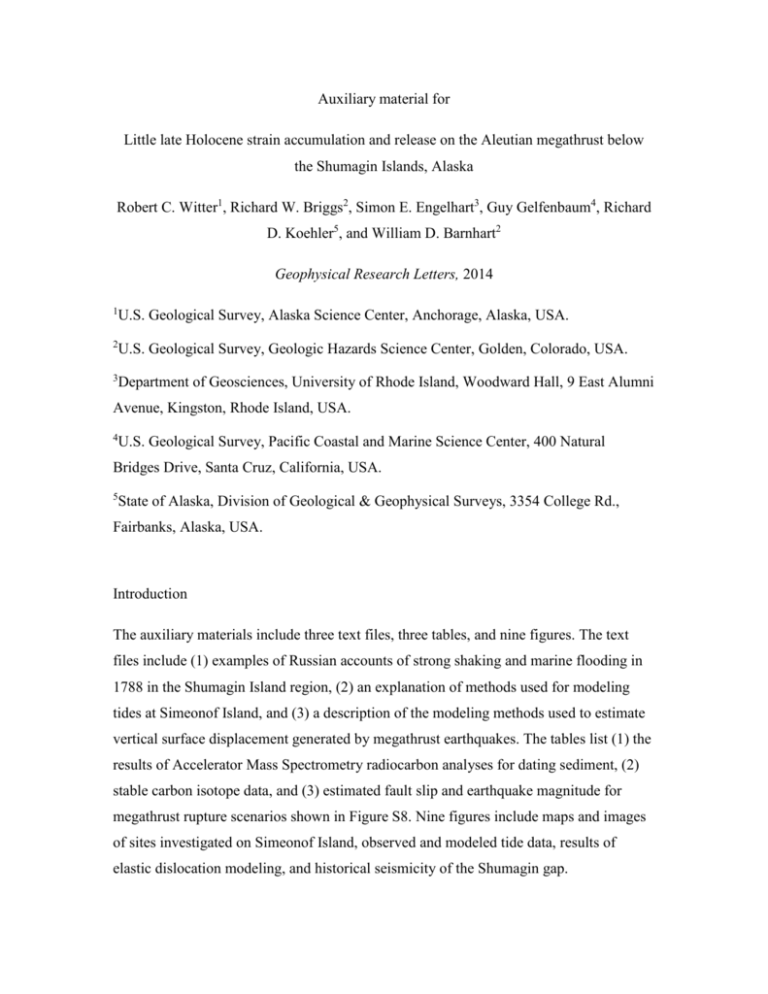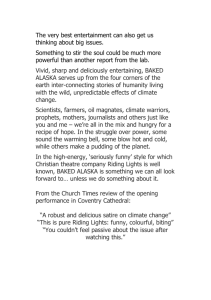READMEAuxiliary_materials
advertisement

Auxiliary material for Little late Holocene strain accumulation and release on the Aleutian megathrust below the Shumagin Islands, Alaska Robert C. Witter1, Richard W. Briggs2, Simon E. Engelhart3, Guy Gelfenbaum4, Richard D. Koehler5, and William D. Barnhart2 Geophysical Research Letters, 2014 1 U.S. Geological Survey, Alaska Science Center, Anchorage, Alaska, USA. 2 U.S. Geological Survey, Geologic Hazards Science Center, Golden, Colorado, USA. 3 Department of Geosciences, University of Rhode Island, Woodward Hall, 9 East Alumni Avenue, Kingston, Rhode Island, USA. 4 U.S. Geological Survey, Pacific Coastal and Marine Science Center, 400 Natural Bridges Drive, Santa Cruz, California, USA. 5 State of Alaska, Division of Geological & Geophysical Surveys, 3354 College Rd., Fairbanks, Alaska, USA. Introduction The auxiliary materials include three text files, three tables, and nine figures. The text files include (1) examples of Russian accounts of strong shaking and marine flooding in 1788 in the Shumagin Island region, (2) an explanation of methods used for modeling tides at Simeonof Island, and (3) a description of the modeling methods used to estimate vertical surface displacement generated by megathrust earthquakes. The tables list (1) the results of Accelerator Mass Spectrometry radiocarbon analyses for dating sediment, (2) stable carbon isotope data, and (3) estimated fault slip and earthquake magnitude for megathrust rupture scenarios shown in Figure S8. Nine figures include maps and images of sites investigated on Simeonof Island, observed and modeled tide data, results of elastic dislocation modeling, and historical seismicity of the Shumagin gap. Files included as auxiliary material: Text S1 (text01.docx) – Historical accounts of earthquakes and tsunamis in 1788. Text S2 (text02.docx) – Establishing elevations relative to a tidal datum on Simeonof Island. Text S3 (text03.docx) – Methods for estimating vertical surface displacements from megathrust slip. Table S1 (ts01.docx) – Radiocarbon data for samples from surficial sediments on Simeonof Island. Individual columns are labeled at the top of the table; footnotes provide further explanation where necessary. Table S2 (ts02.docx) – Variations in stable carbon isotope (δ13C ) values in sediment from a core at Boiler Lagoon. Individual columns are labeled at the top of the table; footnotes provide further explanation where necessary. Table S3 (ts03.docx) – Estimated megathrust slip amount and moment magnitude for hypothetical ruptures of the Shumagin Gap. Individual columns are labeled at the top of the table; footnotes provide further explanation where necessary. Figure S1 (fs01.pdf) – Oblique rendering of 2009 imagery of Simeonof Island. Figure S2 (fs02.pdf) – Comparison of water level observations and modeled tides at Simeonof Island. Methods explained in Text S2. Figure S3 (fs03.pdf) – Bedrock weathering profiles exposed in bluffs along the coast of Simeonof Island. Figure S4 (fs04.pdf) – Image showing hydrologically interconnected lakes on the west coast of Simeonof Island and a map of surficial deposits and geomorphology of Swan Lake area. 2 Figure S5 (fs05.pdf) – Photographs and a map showing lakes and marshes near field camp on Simeonof Island and a stratigraphic profile of coastal deposits. Figure S6 (fs06.pdf) – Map of drained lakes near Rita Bay and a stratigraphic profile. Figure S7 (fs07.pdf) – Map of surficial geology on the northeast side of Simeonof Island and stratigraphic profile. Figure S8 (fs08.pdf) – Results of elastic dislocation modeling. Modeling methods explained in Text S3. Figure S9 (fs09.pdf) – One hundred years of historical seismicity in the Shumagin Gap region. References cited in auxiliary materials: Black, L. T. (2004), Russians in Alaska: 1732-1867, University of Alaska Press, 344 p. Boyd, T. M., J. J. Taber, A. L. Lerner-Lam, and J. Beavan (1988), Seismic rupture and arc segmentation within the Shumagin Islands Seismic Gap, Alaska, Geophysical Research Letters, 15(3), 201-204. Dall, W. H. (1897), Alaska and its Resources, Second ed. Boston, available at: http://archive.org/details/alaskaitsresourc00dallrich Davydov, Gavriil I., Two Voyages to Russian America, 1802–1807, St. Petersburg Morskaia Tipografiya, Vol. 224, I81 2, 154 pages. English translation by Colin Bearne, edited by Richard Pierce (1977), The Limestone Press Kingston, Ontario, Canada,. Egbert, G. D., Bennett, A. F., & Foreman, M. G. (1994), TOPEX/POSEIDON tides estimated using a global inverse model: Journal of Geophysical Research Oceans, v. 99, C12, p. 24821-24852. 3 Egbert, G. D., & Erofeeva, S. Y. (2001), Efficient inverse modeling of barotropic ocean tides: Journal of Atmospheric and Oceanic Technology, v. 19, p. 183-204. Fournier, T. J., and J. T. Freymueller (2007), Transition from locked to creeping subduction in the Shumagin region, Alaska, Geophysical Research Letters, 34(6), L06303. Hayes, G. P., D. J. Wald, and R. L. Johnson (2012), Slab1.0: A three-dimensional model of global subduction zone geometries, Journal of Geophysical Research: Solid Earth, 117(B1), B01302. Kemp, A.C., C.H. Vane, B.P. Horton, and S.J. Culver (2010), Stable carbon isotopes as potential sea-level indicators in salt marshes, North Carolina, USA. The Holocene 20(4) 623–636. Kemp, A. C., Engelhart, S. E., Culver, S. J., Nelson, A. R., Briggs, R., & Haeussler, P. J. (2013). Modern salt-marsh and tidal-flat foraminifera from Sitkinak and Simeonof Islands, southwestern Alaska. Journal of Foraminiferal Research, 43, 88–98. Lander, J. F. (1996), Tsunamis Affecting Alaska 1737-1996, 195 pp., NOAA/NGDC, 284 Boulder, CO. Reimer PJ, Baillie MGL, Bard E, Bayliss A, Beck JW, Blackwell PG, Bronk Ramsey C, Buck CE, Burr GS, Edwards RL, Friedrich M, Grootes PM, Guilderson TP, Hajdas I, Heaton TJ, Hogg AG, Hughen KA, Kaiser KF, Kromer B, McCormac FG, Manning SW, Reimer RW, Richards DA, Southon JR, Talamo S, Turney CSM, van der Plicht J, Weyhenmeyer CE. (2009). IntCal09 and Marine09 radiocarbon age calibration curves, 0–50,000 years cal BP. Radiocarbon 51(4):1111–50. Soloviev, S. L. (1990), Sanak–Kodiak tsunami of 1788, Science of Tsunami Hazards, v. 8, no. 1., p. 34–38. Stuiver, M., and P. J. Reimer (1993), Extended 14C data base and revised CALIB 3.0 14C age calibration program: Radiocarbon, v. 35, p. 215–230. 4 Veniaminov, I. (1840). Zapiski ob ostrovakh Unalashkinskago otdela. St. Petersburg: Rossiisko-amerikanskaia kompaniia. Translated by L. T. Black and R. H. Geoghegan, ed. R.a. Pierce, in Notes on the Islands of the Unalashka District, (Fairbanks: Elmer E. Rasmuson Library Translation Program, University of Alaska Fairbanks, Kingston, Canada: Limestone Press, 1984). 5









